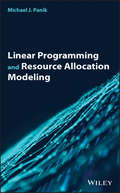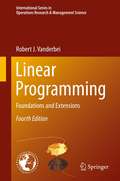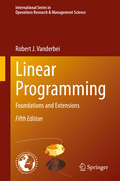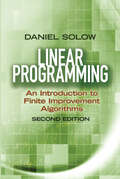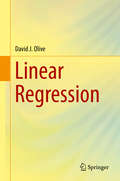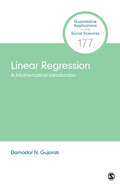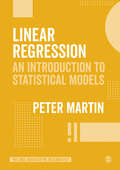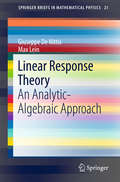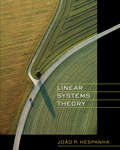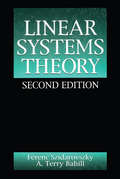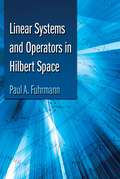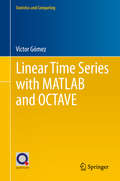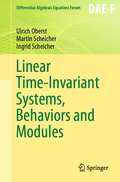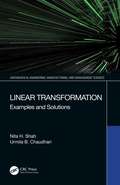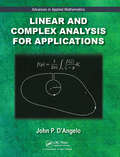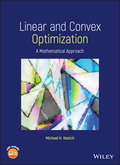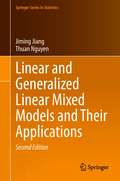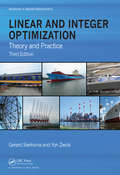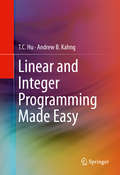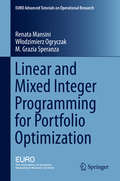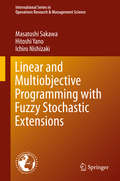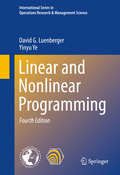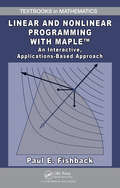- Table View
- List View
Linear Programming and Resource Allocation Modeling
by Michael J. PanikGuides in the application of linear programming to firm decision making, with the goal of giving decision-makers a better understanding of methods at their disposal Useful as a main resource or as a supplement in an economics or management science course, this comprehensive book addresses the deficiencies of other texts when it comes to covering linear programming theory—especially where data envelopment analysis (DEA) is concerned—and provides the foundation for the development of DEA. Linear Programming and Resource Allocation Modeling begins by introducing primal and dual problems via an optimum product mix problem, and reviews the rudiments of vector and matrix operations. It then goes on to cover: the canonical and standard forms of a linear programming problem; the computational aspects of linear programming; variations of the standard simplex theme; duality theory; single- and multiple- process production functions; sensitivity analysis of the optimal solution; structural changes; and parametric programming. The primal and dual problems are then reformulated and re-examined in the context of Lagrangian saddle points, and a host of duality and complementary slackness theorems are offered. The book also covers primal and dual quadratic programs, the complementary pivot method, primal and dual linear fractional functional programs, and (matrix) game theory solutions via linear programming, and data envelopment analysis (DEA). This book: Appeals to those wishing to solve linear optimization problems in areas such as economics, business administration and management, agriculture and energy, strategic planning, public decision making, and health care Fills the need for a linear programming applications component in a management science or economics course Provides a complete treatment of linear programming as applied to activity selection and usage Contains many detailed example problems as well as textual and graphical explanations Linear Programming and Resource Allocation Modeling is an excellent resource for professionals looking to solve linear optimization problems, and advanced undergraduate to beginning graduate level management science or economics students.
Linear Programming: Foundations and Extensions
by Robert J VanderbeiThis Fourth Edition introduces the latest theory and applications in optimization. It emphasizes constrained optimization, beginning with a substantial treatment of linear programming and then proceeding to convex analysis, network flows, integer programming, quadratic programming, and convex optimization. Readers will discover a host of practical business applications as well as non-business applications. Topics are clearly developed with many numerical examples worked out in detail. Specific examples and concrete algorithms precede more abstract topics. With its focus on solving practical problems, the book features free C programs to implement the major algorithms covered, including the two-phase simplex method, primal-dual simplex method, path-following interior-point method, and homogeneous self-dual methods. In addition, the author provides online JAVA applets that illustrate various pivot rules and variants of the simplex method, both for linear programming and for network flows. These C programs and JAVA tools can be found on the book's website. The website also includes new online instructional tools and exercises.
Linear Programming: Foundations and Extensions (International Series in Operations Research & Management Science #285)
by Robert J. VanderbeiThe book provides a broad introduction to both the theory and the application of optimization with a special emphasis on the elegance, importance, and usefulness of the parametric self-dual simplex method. The book assumes that a problem in “standard form,” is a problem with inequality constraints and nonnegative variables. The main new innovation to the book is the use of clickable links to the (newly updated) online app to help students do the trivial but tedious arithmetic when solving optimization problems.The latest edition now includes: a discussion of modern Machine Learning applications, as motivational material; a section explaining Gomory Cuts and an application of integer programming to solve Sudoku problems. Readers will discover a host of practical business applications as well as non-business applications. Topics are clearly developed with many numerical examples worked out in detail. Specific examples and concrete algorithms precede more abstract topics. With its focus on solving practical problems, the book features free C programs to implement the major algorithms covered, including the two-phase simplex method, the primal-dual simplex method, the path-following interior-point method, and and the homogeneous self-dual method. In addition, the author provides online tools that illustrate various pivot rules and variants of the simplex method, both for linear programming and for network flows. These C programs and online pivot tools can be found on the book's website. The website also includes new online instructional tools and exercises.
Linear Programming: Second Edition
by Prof. Daniel SolowSuitable for undergraduate students of mathematics and graduate students of operations research and engineering, this text covers the basic theory and computation for a first course in linear programming. In addition to substantial material on mathematical proof techniques and sophisticated computation methods, the treatment features numerous examples and exercises. An introductory chapter offers a systematic and organized approach to problem formulation. Subsequent chapters explore geometric motivation, proof techniques, linear algebra and algebraic steps related to the simplex algorithm, standard phase 1 problems, and computational implementation of the simplex algorithm. Additional topics include duality theory, issues of sensitivity and parametric analysis, techniques for handling bound constraints, and network flow problems. Helpful appendixes conclude the text, including a new addition that explains how to use Excel to solve linear programming problems.
Linear Regression
by David J. OliveThis text covers both multiple linear regression and some experimental design models. The text uses the response plot to visualize the model and to detect outliers, does not assume that the error distribution has a known parametric distribution, develops prediction intervals that work when the error distribution is unknown, suggests bootstrap hypothesis tests that may be useful for inference after variable selection, and develops prediction regions and large sample theory for the multivariate linear regression model that has m response variables. A relationship between multivariate prediction regions and confidence regions provides a simple way to bootstrap confidence regions. These confidence regions often provide a practical method for testing hypotheses. There is also a chapter on generalized linear models and generalized additive models. There are many R functions to produce response and residual plots, to simulate prediction intervals and hypothesis tests, to detect outliers, and to choose response transformations for multiple linear regression or experimental design models.This text is for graduates and undergraduates with a strong mathematical background. The prerequisites for this text are linear algebra and a calculus based course in statistics.
Linear Regression: A Mathematical Introduction (Quantitative Applications in the Social Sciences #177)
by Damodar N. GujaratiDamodar N. Gujarati’s Linear Regression: A Mathematical Introduction presents linear regression theory in a rigorous, but approachable manner that is accessible to students in all social sciences. This concise title goes step-by-step through the intricacies, and theory and practice of regression analysis. The technical discussion is provided in a clear style that doesn’t overwhelm the reader with abstract mathematics. End-of-chapter exercises test mastery of the content and advanced discussion of some of the topics is offered in the appendices.
Linear Regression: A Mathematical Introduction (Quantitative Applications in the Social Sciences #177)
by Damodar N. GujaratiDamodar N. Gujarati’s Linear Regression: A Mathematical Introduction presents linear regression theory in a rigorous, but approachable manner that is accessible to students in all social sciences. This concise title goes step-by-step through the intricacies, and theory and practice of regression analysis. The technical discussion is provided in a clear style that doesn’t overwhelm the reader with abstract mathematics. End-of-chapter exercises test mastery of the content and advanced discussion of some of the topics is offered in the appendices.
Linear Regression: An Introduction to Statistical Models (The SAGE Quantitative Research Kit)
by Peter MartinThis text introduces the fundamental linear regression models used in quantitative research. It covers both the theory and application of these statistical models, and illustrates them with illuminating graphs. The author offers guidence on: Deciding the most appropriate model to use for your research Conducting simple and multiple linear regression Checking model assumptions and the dangers of overfitting Part of The SAGE Quantitative Research Kit, this book will help you make the crucial steps towards mastering multivariate analysis of social science data.
Linear Regression: An Introduction to Statistical Models (The SAGE Quantitative Research Kit)
by Peter MartinThis text introduces the fundamental linear regression models used in quantitative research. It covers both the theory and application of these statistical models, and illustrates them with illuminating graphs. The author offers guidence on: Deciding the most appropriate model to use for your research Conducting simple and multiple linear regression Checking model assumptions and the dangers of overfitting Part of The SAGE Quantitative Research Kit, this book will help you make the crucial steps towards mastering multivariate analysis of social science data.
Linear Response Theory
by Giuseppe De Nittis Max LeinThis book presents a modern and systematic approach to Linear Response Theory (LRT) by combining analytic and algebraic ideas. LRT is a tool to study systems that are driven out of equilibrium by external perturbations. In particular the reader is provided with a new and robust tool to implement LRT for a wide array of systems. The proposed formalism in fact applies to periodic and random systems in the discrete and the continuum. After a short introduction describing the structure of the book, its aim and motivation, the basic elements of the theory are presented in chapter 2. The mathematical framework of the theory is outlined in chapters 3-5: the relevant von Neumann algebras, noncommutative $L^p$- and Sobolev spaces are introduced; their construction is then made explicit for common physical systems; the notion of isopectral perturbations and the associated dynamics are studied. Chapter 6 is dedicated to the main results, proofs of the Kubo and Kubo-Streda formulas. The book closes with a chapter about possible future developments and applications of the theory to periodic light conductors. The book addresses a wide audience of mathematical physicists, focusing on the conceptual aspects rather than technical details and making algebraic methods accessible to analysts.
Linear Systems Theory
by João P. HespanhaLinear systems theory is the cornerstone of control theory and a well-established discipline that focuses on linear differential equations from the perspective of control and estimation. In this textbook, João Hespanha covers the key topics of the field in a unique lecture-style format, making the book easy to use for instructors and students. He looks at system representation, stability, controllability and state feedback, observability and state estimation, and realization theory. He provides the background for advanced modern control design techniques and feedback linearization, and examines advanced foundational topics such as multivariable poles and zeros, and LQG/LQR.The textbook presents only the most essential mathematical derivations, and places comments, discussion, and terminology in sidebars so that readers can follow the core material easily and without distraction. Annotated proofs with sidebars explain the techniques of proof construction, including contradiction, contraposition, cycles of implications to prove equivalence, and the difference between necessity and sufficiency. Annotated theoretical developments also use sidebars to discuss relevant commands available in MATLAB, allowing students to understand these important tools. The balanced chapters can each be covered in approximately two hours of lecture time, simplifying course planning and student review. Solutions to the theoretical and computational exercises are also available for instructors.Easy-to-use textbook in unique lecture-style format Sidebars explain topics in further detail Annotated proofs and discussions of MATLAB commands Balanced chapters can each be taught in two hours of course lecture Solutions to exercises available to instructors
Linear Systems Theory (Systems Engineering Ser.)
by Ferenc SzidarovszkyThis second edition comprehensively presents important tools of linear systems theory, including differential and difference equations, Laplace and Z transforms, and more.Linear Systems Theory discusses:Nonlinear and linear systems in the state space form and through the transfer function methodStability, including marginal stability, asymptotical stability, global asymptotical stability, uniform stability, uniform exponential stability, and BIBO stabilityControllabilityObservabilityCanonical formsSystem realizations and minimal realizations, including state space approach and transfer function realizationsSystem designKalman filtersNonnegative systemsAdaptive controlNeural networksThe book focuses mainly on applications in electrical engineering, but it provides examples for most branches of engineering, economics, and social sciences.What's New in the Second Edition?Case studies drawn mainly from electrical and mechanical engineering applications, replacing many of the longer case studiesExpanded explanations of both linear and nonlinear systems as well as new problem sets at the end of each chapterIllustrative examples in all the chaptersAn introduction and analysis of new stability conceptsAn expanded chapter on neural networks, analyzing advances that have occurred in that field since the first editionAlthough more mainstream than its predecessor, this revision maintains the rigorous mathematical approach of the first edition, providing fast, efficient development of the material.Linear Systems Theory enables its reader to develop his or her capabilities for modeling dynamic phenomena, examining their properties, and applying them to real-life situations.
Linear Systems and Operators in Hilbert Space (Dover Books on Mathematics)
by Paul A. FuhrmannA treatment of system theory within the context of finite dimensional spaces, this text is appropriate for students with no previous experience of operator theory. The three-part approach, with notes and references for each section, covers linear algebra and finite dimensional systems, operators in Hilbert space, and linear systems in Hilbert space. 1981 edition.
Linear Time Series with MATLAB and OCTAVE (Statistics and Computing)
by Víctor GómezThis book presents an introduction to linear univariate and multivariate time series analysis, providing brief theoretical insights into each topic, and from the beginning illustrating the theory with software examples. As such, it quickly introduces readers to the peculiarities of each subject from both theoretical and the practical points of view. It also includes numerous examples and real-world applications that demonstrate how to handle different types of time series data. The associated software package, SSMMATLAB, is written in MATLAB and also runs on the free OCTAVE platform. The book focuses on linear time series models using a state space approach, with the Kalman filter and smoother as the main tools for model estimation, prediction and signal extraction. A chapter on state space models describes these tools and provides examples of their use with general state space models. Other topics discussed in the book include ARIMA; and transfer function and structural models; as well as signal extraction using the canonical decomposition in the univariate case, and VAR, VARMA, cointegrated VARMA, VARX, VARMAX, and multivariate structural models in the multivariate case. It also addresses spectral analysis, the use of fixed filters in a model-based approach, and automatic model identification procedures for ARIMA and transfer function models in the presence of outliers, interventions, complex seasonal patterns and other effects like Easter, trading day, etc. This book is intended for both students and researchers in various fields dealing with time series. The software provides numerous automatic procedures to handle common practical situations, but at the same time, readers with programming skills can write their own programs to deal with specific problems. Although the theoretical introduction to each topic is kept to a minimum, readers can consult the companion book ‘Multivariate Time Series With Linear State Space Structure’, by the same author, if they require more details.
Linear Time-Invariant Systems, Behaviors and Modules (Differential-Algebraic Equations Forum)
by Ulrich Oberst Martin Scheicher Ingrid ScheicherThis book comprehensively examines various significant aspects of linear time-invariant systems theory, both for continuous-time and discrete-time. Using a number of new mathematical methods it provides complete and exact proofs of all the systems theoretic and electrical engineering results, as well as important results and algorithms demonstrated with nontrivial computer examples. The book is intended for readers who have completed the first two years of a university mathematics course. All further mathematical results required are proven in the book.
Linear Transformation: Examples and Solutions (Mathematical Engineering, Manufacturing, and Management Sciences)
by Nita H. Shah Urmila B. ChaudhariThis book introduces linear transformation and its key results, which have applications in engineering, physics, and various branches of mathematics. Linear transformation is a difficult subject for students. This concise text provides an in-depth overview of linear trans-formation. It provides multiple-choice questions, covers enough examples for the reader to gain a clear understanding, and includes exact methods with specific shortcuts to reach solutions for particular problems. Research scholars and students working in the fields of engineering, physics, and different branches of mathematics need to learn the concepts of linear transformation to solve their problems. This book will serve their need instead of having to use the more complex texts that contain more concepts then needed. The chapters mainly discuss the definition of linear transformation, properties of linear transformation, linear operators, composition of two or more linear transformations, kernels and range of linear transformation, inverse transformation, one-to-one and onto transformation, isomorphism, matrix linear transformation, and similarity of two matrices.
Linear and Complex Analysis for Applications (Advances in Applied Mathematics)
by John P. D'Angelo<p>Linear and Complex Analysis for Applications aims to unify various parts of mathematical analysis in an engaging manner and to provide a diverse and unusual collection of applications, both to other fields of mathematics and to physics and engineering. The book evolved from several of the author’s teaching experiences, his research in complex analysis in several variables, and many conversations with friends and colleagues. <p>It has three primary goals: <p> <li>to develop enough linear analysis and complex variable theory to prepare students in engineering or applied mathematics for advanced work, <li>to unify many distinct and seemingly isolated topics, <li>to show mathematics as both interesting and useful, especially via the juxtaposition of examples and theorems.</li> <p> <p>The book realizes these goals by beginning with reviews of Linear Algebra, Complex Numbers, and topics from Calculus III. As the topics are being reviewed, new material is inserted to help the student develop skill in both computation and theory. The material on linear algebra includes infinite-dimensional examples arising from elementary calculus and differential equations. Line and surface integrals are computed both in the language of classical vector analysis and by using differential forms. Connections among the topics and applications appear throughout the book. <p>The text weaves abstract mathematics, routine computational problems, and applications into a coherent whole, whose unifying theme is linear systems. It includes many unusual examples and contains more than 450 exercises.</p>
Linear and Convex Optimization: A Mathematical Approach
by Michael H. VeatchDiscover the practical impacts of current methods of optimization with this approachable, one-stop resource Linear and Convex Optimization: A Mathematical Approach delivers a concise and unified treatment of optimization with a focus on developing insights in problem structure, modeling, and algorithms. Convex optimization problems are covered in detail because of their many applications and the fast algorithms that have been developed to solve them. Experienced researcher and undergraduate teacher Mike Veatch presents the main algorithms used in linear, integer, and convex optimization in a mathematical style with an emphasis on what makes a class of problems practically solvable and developing insight into algorithms geometrically. Principles of algorithm design and the speed of algorithms are discussed in detail, requiring no background in algorithms. The book offers a breadth of recent applications to demonstrate the many areas in which optimization is successfully and frequently used, while the process of formulating optimization problems is addressed throughout. Linear and Convex Optimization contains a wide variety of features, including: Coverage of current methods in optimization in a style and level that remains appealing and accessible for mathematically trained undergraduates Enhanced insights into a few algorithms, instead of presenting many algorithms in cursory fashion An emphasis on the formulation of large, data-driven optimization problems Inclusion of linear, integer, and convex optimization, covering many practically solvable problems using algorithms that share many of the same concepts Presentation of a broad range of applications to fields like online marketing, disaster response, humanitarian development, public sector planning, health delivery, manufacturing, and supply chain management Ideal for upper level undergraduate mathematics majors with an interest in practical applications of mathematics, this book will also appeal to business, economics, computer science, and operations research majors with at least two years of mathematics training.
Linear and Generalized Linear Mixed Models and Their Applications (Springer Series in Statistics)
by Jiming Jiang Thuan NguyenThis book covers two major classes of mixed effects models, linear mixed models and generalized linear mixed models. It presents an up-to-date account of theory and methods in analysis of these models as well as their applications in various fields. The book offers a systematic approach to inference about non-Gaussian linear mixed models. Furthermore, it includes recently developed methods, such as mixed model diagnostics, mixed model selection, and jackknife method in the context of mixed models. The book is aimed at students, researchers and other practitioners who are interested in using mixed models for statistical data analysis.
Linear and Integer Optimization: Theory and Practice, Third Edition (Advances in Applied Mathematics)
by Gerard Sierksma Yori ZwolsPresenting a strong and clear relationship between theory and practice, Linear and Integer Optimization: Theory and Practice is divided into two main parts. The first covers the theory of linear and integer optimization, including both basic and advanced topics. Dantzig's simplex algorithm, duality, sensitivity analysis, integer optimization models
Linear and Integer Programming Made Easy
by T. C. Hu Andrew B. KahngThis textbook provides concise coverage of the basics of linear and integer programming which, with megatrends toward optimization, machine learning, big data, etc. , are becoming fundamental toolkits for data and information science and technology. The authors' approach is accessible to students from almost all fields of engineering, including operations research, statistics, machine learning, control system design, scheduling, formal verification and computer vision. The presentations enables the basis for numerous approaches to solving hard combinatorial optimization problems through randomization and approximation. Readers will learn to cast various problems that may arise in their research as optimization problems, understand the cases where the optimization problem will be linear, choose appropriate solution methods and interpret results appropriately.
Linear and Mixed Integer Programming for Portfolio Optimization
by Renata Mansini Włodzimierz Ogryczak M. Grazia SperanzaThis book presents solutions to the general problem of single period portfolio optimization. It introduces different linear models, arising from different performance measures, and the mixed integer linear models resulting from the introduction of real features. Other linear models, such as models for portfolio rebalancing and index tracking, are also covered. The book discusses computational issues and provides a theoretical framework, including the concepts of risk-averse preferences, stochastic dominance and coherent risk measures. The material is presented in a style that requires no background in finance or in portfolio optimization; some experience in linear and mixed integer models, however, is required. The book is thoroughly didactic, supplementing the concepts with comments and illustrative examples.
Linear and Multiobjective Programming with Fuzzy Stochastic Extensions
by Masatoshi Sakawa Hitoshi Yano Ichiro NishizakiAlthough several books or monographs on multiobjective optimization under uncertainty have been published, there seems to be no book which starts with an introductory chapter of linear programming and is designed to incorporate both fuzziness and randomness into multiobjective programming in a unified way. In this book, five major topics, linear programming, multiobjective programming, fuzzy programming, stochastic programming, and fuzzy stochastic programming, are presented in a comprehensive manner. Especially, the last four topics together comprise the main characteristics of this book, and special stress is placed on interactive decision making aspects of multiobjective programming for human-centered systems in most realistic situations under fuzziness and/or randomness. Organization of each chapter is briefly summarized as follows: Chapter 2 is a concise and condensed description of the theory of linear programming and its algorithms. Chapter 3 discusses fundamental notions and methods of multiobjective linear programming and concludes with interactive multiobjective linear programming. In Chapter 4, starting with clear explanations of fuzzy linear programming and fuzzy multiobjective linear programming, interactive fuzzy multiobjective linear programming is presented. Chapter 5 gives detailed explanations of fundamental notions and methods of stochastic programming including two-stage programming and chance constrained programming. Chapter 6 develops several interactive fuzzy programming approaches to multiobjective stochastic programming problems. Applications to purchase and transportation planning for food retailing are considered in Chapter 7. The book is self-contained because of the three appendices and answers to problems. Appendix A contains a brief summary of the topics from linear algebra. Pertinent results from nonlinear programming are summarized in Appendix B. Appendix C is a clear explanation of the Excel Solver, one of the easiest ways to solve optimization problems, through the use of simple examples of linear and nonlinear programming.
Linear and Nonlinear Programming
by David G. Luenberger Yinyu YeThis new edition covers the central concepts of practical optimization techniques, with an emphasis on methods that are both state-of-the-art and popular. One major insight is the connection between the purely analytical character of an optimization problem and the behavior of algorithms used to solve a problem. This was a major theme of the first edition of this book and the fourth edition expands and further illustrates this relationship. As in the earlier editions, the material in this fourth edition is organized into three separate parts. Part I is a self-contained introduction to linear programming. The presentation in this part is fairly conventional, covering the main elements of the underlying theory of linear programming, many of the most effective numerical algorithms, and many of its important special applications. Part II, which is independent of Part I, covers the theory of unconstrained optimization, including both derivations of the appropriate optimality conditions and an introduction to basic algorithms. This part of the book explores the general properties of algorithms and defines various notions of convergence. Part III extends the concepts developed in the second part to constrained optimization problems. Except for a few isolated sections, this part is also independent of Part I. It is possible to go directly into Parts II and III omitting Part I, and, in fact, the book has been used in this way in many universities. New to this edition is a chapter devoted to Conic Linear Programming, a powerful generalization of Linear Programming. Indeed, many conic structures are possible and useful in a variety of applications. It must be recognized, however, that conic linear programming is an advanced topic, requiring special study. Another important topic is an accelerated steepest descent method that exhibits superior convergence properties, and for this reason, has become quite popular. The proof of the convergence property for both standard and accelerated steepest descent methods are presented in Chapter 8. As in previous editions, end-of-chapter exercises appear for all chapters. From the reviews of the Third Edition: ". . . this very well-written book is a classic textbook in Optimization. It should be present in the bookcase of each student, researcher, and specialist from the host of disciplines from which practical optimization applications are drawn. " (Jean-Jacques Strodiot, Zentralblatt MATH, Vol. 1207, 2011)
Linear and Nonlinear Programming with Maple: An Interactive, Applications-Based Approach
by Paul E. FishbackHelps Students Understand Mathematical Programming Principles and Solve Real-World ApplicationsSupplies enough mathematical rigor yet accessible enough for undergraduatesIntegrating a hands-on learning approach, a strong linear algebra focus, Maple software, and real-world applications, Linear and Nonlinear Programming with Maple : An Interactive,
